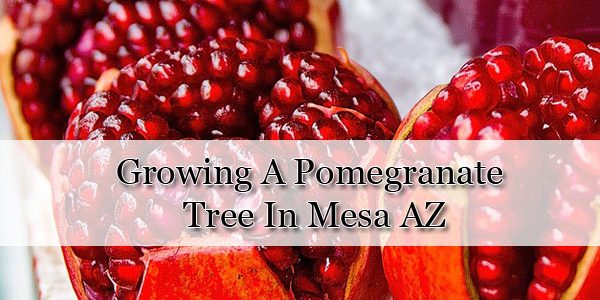There’s nothing like having a beautifully landscaped yard. But it’s even better when parts of it are edible. You can’t run out and gnaw on your tulips. So growing a pomegranate tree in Mesa is a great option. That way you can have your yard, and eat it too. The pomegranate tree’s beautiful red fruit against the dark green leaves provides a wonderful contrast and interest to your yard. In addition if you already love pomegranate you won’t have to go pay the grocer to get your favorite fruit.
Pomegranates are native to Asia and Southeastern Europe. They have also been extensively cultivated in ancient Babylonia, Egypt, Iran, and India. As far as pomegranate trees history in North America they were brought here by the Spanish. First they were brought to Mexico and then to California and Arizona.
The pomegranate tree is easy to grow in your Mesa garden. It has beautiful flowers and is well suited to our Mesa desert environment. They might be called a tree but they are somewhere between a bush and a tree. Typically growing anywhere from 6 – 12 feet high they are a deciduous and will lose their leaves for the fall and winter. They relish the full sun and summer heat, but can withstand some pretty stout cold days. They can survive as low as 10°F. During the hotter, drier parts of the summer they might need a little tending. Pomegranate trees are mildly drought resistant, but better safe than sorry and help them out with some water during the harshest parts of summer. This will help ensure that you get more, better fruit.
What Pomegranate Tastes Like

Pomegranate flavor will vary some depending on the soil and amount of water they got during the growing season. However most will have a tart, sweet taste. Despite the tendency of the seeds to stain skin with a reddish hue, they are the favorite part of the fruit. Pomegranate seeds are bursting with flavor. They have a juicy, sweet taste that people in Mesa love.
What To Do With Pomegranate
Unlike fruits like the banana or orange where you simply grab a hold and peel the fruit, it takes a little more effort to get into a pomegranate. But you will be rewarded for your efforts with a unique flavor and a deliciously sweet fruit. Here’s how to get one open.
Opening A Pomegranate

The pomegranate typically has a leathery pinkish to red skin. It may look hard to open, but with a little knowledge it becomes very simple. Here’s the specifics on how to make it easy and get to enjoying the fruits of your labor. Always cut away from yourself and use common sense when handling your knives.
Pom Preparation
- Cut off the top of the pomegranate
- Slice down the edges or ribs of the pomegranate
- Try to cut deep enough to crack the skin, but don’t score the seeds
- Gripping the top where you cut initially pull outwards and crack it open
- Enjoy the fruit of your labors
Ways To Enjoy Pomegranates

Not being one of the fruits they teach you much about in elementary and not being one of the best known fruits a lot of people are hesitant to plant one of these beauties in their backyard. Here are some ideas of what you can do with the fruit.
Here’s just a few ways that people love enjoying their Pomegranates:
Make A Stake Glaze With Pomegranate – After extracting the juice from your pomegranate you can combined it with some coarsely ground peppercorn, rosemary, olive oil, brown sugar, balsamic vinegar to make a wonderfully complex glaze to set your steaks apart.
Throw Some Seeds In Your Salad – After you’ve got your Pomegranate cracked open you can sprinkle them into your tossed green salad with some pear slices and blue cheese. The Pomegranate gives it that extra depth and flavor.
Toss Some Seeds In Your Breakfast – Many pomegranate lovers will add the seeds to a variety of foods. From throwing a few into yogurt to simply making a breakfast salad having some pomegranate seeds give
Planting A Pomegranate Tree In Your Mesa Backyard

While the most common pomegranate trees that are grown in Arizona and California is the “Wonderful” variety of Pomegranate, there are other varieties. The Wonderful pomegranate grows best in the Mesa area which is why it is so prolific.
Choosing A Site For Your Pomegranate Tree – Like most trees that thrive in hot dry desert like areas like Mesa the Pomegranate tree relishes the full sun. In fact a successful harvest of pomegranate is dependent on getting enough sun so it can grow properly. If you don’t have a backyard or spot that gets that full sun every day, pick the spot that gets the least amount of shade.
The soil in the site you pick needs to be a well draining soil, like a sandy soil. Loam soil also offers good drainage. They grow well in alkaline soils, but some growers believe that they must be growing in slightly acidic soils. The biggest problem is if you have a clay type soil, which will retain too much water and risk getting root rot.

Planting Your Pomegranate Tree – In some areas of the country that has frost problems they have to wait for spring and after the first frost. In Mesa you have a little more flexibility. But earlier in the year is better. This will help get the tree established with a healthy root system before the intense Mesa summers take hold. If you are planting the tree yourself you need to have a hole dug about 2 feet deep and about 2 feet wide.
Watering Your Pomegranate Tree – For newly planted trees an immediate watering is necessary to help the soil settle. Continue to do daily watering until the tree grows new leaves. This is a sign that your pomegranate is settled into its new home. After you’ve got new leaf growth you’ll want to start spacing you’re watering out and end up at about once a week. This can vary depending on the heat for the week, harsher weeks require a little more watering. When your pomegranate is flower or fruit is developing you will want to give your tree a deep watering every week.
Fertilizing Your Pomegranate Tree – For the pomegranate a ammonium sulfate fertilizer is a great option. Using about 1/3 of a cup sprinkle your fertilizer on the ground around the roots to enrich the soil with the nutrients that you tree needs to grow the best it can. You’ll want to do this about 3 times during the first year of growth. The best months to do this fertilization are February, May and September.

Pruning and Weeding – Because the pomegranate grows a bit like a shrub some of the limbs will be closer to the ground. You don’t want weeds to grow up into the tree and strangle some of it’s health. When it comes to pruning the pomegranate tree some owners like to do more than simply pruning. They like to form the tree to be a shape they prefer. As much as the pomegranate tree grows as a bush you can make it look like a tree with proper pruning. Shortly after your tree is established you will want to use a pair of clippers or shears to cut the “suckers” from the base of the pomegranate tree. This is only for appearances, not a necessary step. If you let it grow naturally it will take on a more bush like appearance.
The only necessary pruning is removing dead or damaged sections. In the spring you will want to cut away sections that look like they are dying, dead, or struggling.
Pest Management – There are two insects that pose a danger to your pomegranate fruit. The aphid and pomegranate butterfly. The butterfly is pretty rare and can be guarded against by simply getting some butterfly spray from your local nursery. Some owners wouldn’t ever even imagine killing the butterflies and choose to coexist with them and sacrifice a little bit of their fruit. Ultimately the choice is up to the individual. The spray will make the butterflies stay away and avoid them laying their larvae on your trees. The aphids can also be managed using sprays that are available from your local nursery.
Mold Management – Apart from pests running your fruit you have to be careful not to ruin the tree yourself. Avoid over watering your pomegranate tree, follow the guide we have laid out to avoid root rot and problems with your tree. Too much water will mean that the soil cannot effectively drain and will leave the tree in danger of developing mold.

If you’re ready to choose and have a pomegranate tree planted at your Mesa home contact the knowledgeable and helpful folks at your local A&P Nursery.







